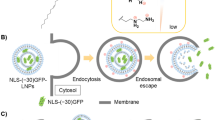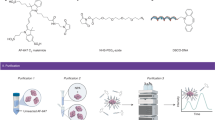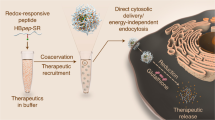Abstract
Intracellular delivery of proteins remains challenging. Here, we present a simple and general platform for the efficient loading and delivery of proteins using a methoxy-poly(ethylene glycol)-block-poly(L-phosphotyrosine) (mPEG-b-PpY)-templated calcium phosphate (CaP) hybrid nanoparticle. By doping hybrid CaP nanoparticles with Zn2+ (CaP-Zn), recombinant proteins bearing a histidine tag can be conveniently loaded by harnessing the His-Zn coordination bond. The resulting protein@CaP-Zn nanoparticles display low toxicity and are tunable, uniform in size, stable under physiological conditions, and degradable in acidic milieu for responsive release. Proteins loaded onto the CaP-Zn nanoparticle can be protected from proteolytic degradation and effectively delivered to intracellular spaces. This work may open up opportunities for protein activity preservation and facilitate the intracellular delivery of recombinant protein therapeutics.
This is a preview of subscription content, access via your institution
Access options
Subscribe to this journal
Receive 12 print issues and online access
$259.00 per year
only $21.58 per issue
Buy this article
- Purchase on Springer Link
- Instant access to full article PDF
Prices may be subject to local taxes which are calculated during checkout





Similar content being viewed by others
References
Leader B, Baca QJ, Golan DE. Protein therapeutics: a summary and pharmacological classification. Nat Rev Drug Discov. 2008;7:21–39.
Urquhart L. Top companies and drugs by sales in 2020. Nat Rev Drug Discov. 2021;20:253.
Lv J, Fan Q, Wang H, Cheng Y. Polymers for cytosolic protein delivery. Biomaterials. 2019;218:119358.
Gu Z, Biswas A, Zhao M, Tang Y. Tailoring nanocarriers for intracellular protein delivery. Chem Soc Rev. 2011;40:3638–55.
Scaletti F, Hardie J, Lee YW, Luther DC, Ray M, Rotello VM. Protein delivery into cells using inorganic nanoparticle-protein supramolecular assemblies. Chem Soc Rev. 2018;47:3421–32.
Su S, Wang YY, Du FS, Lu H, Li ZC. Dynamic covalent bond‐assisted programmed and traceless protein release: high loading nanogel for systemic and cytosolic delivery. Adv Funct Mater. 2018;28:1805287.
Wang R, Sheng K, Hou Y, Sun J, Lu H. Tailoring cationic helical polypeptides for efficient cytosolic protein delivery. Chem Res Chin Univ. 2020;36:134–8.
Li X, Wei Y, Wu Y, Yin L. Hypoxia-induced pro-protein therapy assisted by a self-catalyzed nanozymogen. Angew Chem Int Ed. 2020;59:22544–53.
He H, Chen Y, Li Y, Song Z, Zhong Y, Zhu R, et al. Effective and selective anti-cancer protein delivery via all-functions-in-one nanocarriers coupled with visible light-responsive, reversible protein engineering. Adv Funct Mater. 2018;28:1706710.
Yao P, Zhang Y, Meng H, Sun H, Zhong Z. Smart polymersomes dually functionalized with cRGD and fusogenic GALA peptides enable specific and high-efficiency cytosolic delivery of apoptotic proteins. Biomacromolecules. 2019;20:184–91.
Tong T, Wang L, You X, Wu J. Nano and microscale delivery platforms for enhanced oral peptide/protein bioavailability. Biomater Sci. 2020;8:5804–23.
Li Y, Bolinger J, Yu Y, Glass Z, Shi N, Yang L, et al. Intracellular delivery and biodistribution study of CRISPR/Cas9 ribonucleoprotein loaded bioreducible lipidoid nanoparticles. Biomater Sci. 2019;7:596–606.
Li Y, Jarvis R, Zhu K, Glass Z, Ogurlu R, Gao P, et al. Protein and mRNA delivery enabled by cholesteryl-based biodegradable lipidoid nanoparticles. Angew Chem Int Ed. 2020;59:14957–64.
Solaro R, Chiellini F, Battisti A. Targeted delivery of protein drugs by nanocarriers. Materials. 2010;3:1928–80.
Zhou HX, Pang X. Electrostatic interactions in protein structure, folding, binding, and condensation. Chem Rev. 2018;118:1691–741.
Dutta K, Kanjilal P, Das R, Thayumanavan S. Synergistic interplay of covalent and non-covalent interactions in reactive polymer nanoassembly facilitates intracellular delivery of antibodies. Angew Chem Int Ed. 2021;60:1821–30.
Ekladious I, Colson YL, Grinstaff MW. Polymer-drug conjugate therapeutics: advances, insights and prospects. Nat Rev Drug Discov. 2019;18:273–94.
Wang H, Hou Y, Hu Y, Dou J, Shen Y, Wang Y, et al. Enzyme-activatable interferon–poly(α-amino acid) conjugates for tumor microenvironment potentiation. Biomacromolecules. 2019;20:3000–8.
Shen BQ, Xu K, Liu L, Raab H, Bhakta S, Kenrick M, et al. Conjugation site modulates the in vivo stability and therapeutic activity of antibody-drug conjugates. Nat Biotechnol. 2012;30:184–9.
Honda Y, Nomoto T, Matsui M, Takemoto H, Kaihara Y, Miura Y, et al. Sequential self-assembly using tannic acid and phenylboronic acid-modified copolymers for potential protein delivery. Biomacromolecules. 2020;21:3826–35.
Lv J, Wang C, Li H, Li Z, Fan Q, Zhang Y, et al. Bifunctional and bioreducible dendrimer bearing a fluoroalkyl tail for efficient protein delivery both in vitro and in vivo. Nano Lett. 2020;20:8600–7.
Ren L, Lv J, Wang H, Cheng Y. A coordinative dendrimer achieves excellent efficiency in cytosolic protein and peptide delivery. Angew Chem Int Ed. 2020;59:4711–9.
Zhang S, Cheng Y. Boronic acid-engineered gold nanoparticles for cytosolic protein delivery. Biomater Sci. 2020;8:3741–50.
Liu J, Luo T, Xue Y, Mao L, Stang PJ, Wang M. Hierarchical self-assembly of discrete metal-organic cages into supramolecular nanoparticles for intracellular protein delivery. Angew Chem Int Ed. 2021;60:5429–35.
Yang X, Tang Q, Jiang Y, Zhang M, Wang M, Mao L. Nanoscale ATP-responsive zeolitic imidazole framework-90 as a general platform for cytosolic protein delivery and genome editing. J Am Chem Soc. 2019;141:3782–6.
Hochuli E, Bannwarth W, Döbeli H, Gentz R, Stüber D. Genetic approach to facilitate purification of recombinant proteins with a novel metal chelate adsorbent. Nat Biotechnol. 1988;6:1321–5.
Porath J. Immobilized metal ion affinity chromatography. Protein Expr Purif. 1992;3:263–81.
Postupalenko V, Desplancq D, Orlov I, Arntz Y, Spehner D, Mely Y, et al. Protein delivery system containing a nickel-immobilized polymer for multimerization of affinity-purified His-tagged proteins enhances cytosolic transfer. Angew Chem Int Ed. 2015;54:10583–6.
Roder R, Preiss T, Hirschle P, Steinborn B, Zimpel A, Hohn M, et al. Multifunctional nanoparticles by coordinative self-assembly of His-tagged units with metal-organic frameworks. J Am Chem Soc 2017;139:2359–68.
Li Y, Li AC, Xu Q. Intracellular delivery of His-tagged genome-editing proteins enabled by nitrilotriacetic acid-containing lipidoid nanoparticles. Adv Healthc Mater. 2019;8:e1800996.
Huang D, He B, Mi P. Calcium phosphate nanocarriers for drug delivery to tumors: imaging, therapy and theranostics. Biomater Sci. 2019;7:3942–60.
LeGeros RZ. Biodegradation and bioresorption of calcium phosphate ceramics. Clin Mater. 1993;14:65–88.
Shi H, Cheng Q, Yuan S, Ding X, Liu Y. Human serum albumin conjugated nanoparticles for pH and redox-responsive delivery of a prodrug of cisplatin. Chemistry. 2015;21:16547–54.
Nomoto T, Fukushima S, Kumagai M, Miyazaki K, Inoue A, Mi P, et al. Calcium phosphate-based organic-inorganic hybrid nanocarriers with pH-responsive on/off switch for photodynamic therapy. Biomater Sci. 2016;4:826–38.
Kakizawa Y, Miyata K, Furukawa S, Kataoka K. Size-controlled formation of a calcium phosphate-based organic–inorganic hybrid vector for gene delivery using poly(ethylene glycol)-block-poly(aspartic acid). Adv Mater. 2004;16:699–702.
Choi KY, Silvestre OF, Huang X, Min KH, Howard GP, Hida N, et al. Versatile RNA interference nanoplatform for systemic delivery of RNAs. ACS Nano. 2014;8:4559–70.
Pittella F, Cabral H, Maeda Y, Mi P, Watanabe S, Takemoto H, et al. Systemic siRNA delivery to a spontaneous pancreatic tumor model in transgenic mice by PEGylated calcium phosphate hybrid micelles. J Control Release. 2014;178:18–24.
Kakizawa Y, Furukawa S, Kataoka K. Block copolymer-coated calcium phosphate nanoparticles sensing intracellular environment for oligodeoxynucleotide and siRNA delivery. J Control Release. 2004;97:345–56.
Sun Y, Hou Y, Zhou X, Yuan J, Wang J, Lu H. Controlled synthesis and enzyme-induced hydrogelation of poly(l-phosphotyrosine)s via ring-opening polymerization of α-amino acid N-carboxyanhydride. ACS Macro Lett. 2015;4:1000–3.
Hou Y, Wang Y, Wang R, Bao W, Xi X, Sun Y, et al. Harnessing phosphato-platinum bonding induced supramolecular assembly for systemic cisplatin delivery. ACS Appl Mater Interfaces. 2017;9:17757–68.
Li SL, Hou Y, Hu Y, Yu J, Wei W, Lu H. Phosphatase-triggered cell-selective release of a Pt(iv)-backboned prodrug-like polymer for an improved therapeutic index. Biomater Sci. 2017;5:1558–66.
Li SL, Wang Y, Zhang J, Wei W, Lu H. Targeted delivery of a guanidine-pendant Pt(iv)-backboned poly-prodrug by an anisamide-functionalized polypeptide. J Mater Chem B. 2017;5:9546–57.
Kohri K, Umekawa T, Kodama M, Katayama Y, Ishikawa Y, Takada M, et al. Inhibitory effect of glutamic acid and aspartic acid on calcium oxalate crystal formation. Eur Urol. 1990;17:173–7.
Mi P, Kokuryo D, Cabral H, Wu H, Terada Y, Saga T, et al. A pH-activatable nanoparticle with signal-amplification capabilities for non-invasive imaging of tumour malignancy. Nat Nanotechnol. 2016;11:724–30.
Hou Y, Yuan J, Zhou Y, Yu J, Lu H, Concise A. Approach to site-specific topological protein-poly(amino acid) conjugates enabled by in situ-generated functionalities. J Am Chem Soc. 2016;138:10995–11000.
Mi P, Kokuryo D, Cabral H, Kumagai M, Nomoto T, Aoki I, et al. Hydrothermally synthesized PEGylated calcium phosphate nanoparticles incorporating Gd-DTPA for contrast enhanced MRI diagnosis of solid tumors. J Control Release. 2014;174:63–71.
Acknowledgements
This work was financially supported by the National Key Research and Development Program of China (No. 2016YFA0201400). We are thankful for the grant from the National Natural Science Foundation of China (21722401).
Author information
Authors and Affiliations
Corresponding author
Ethics declarations
Conflict of interest
The authors declare no competing interests.
Additional information
Publisher’s note Springer Nature remains neutral with regard to jurisdictional claims in published maps and institutional affiliations.
Supplementary information
Rights and permissions
About this article
Cite this article
Zhou, H., Wang, Y. & Lu, H. Intracellular delivery of His-tagged proteins via a hybrid organic–inorganic nanoparticle. Polym J 53, 1259–1267 (2021). https://doi.org/10.1038/s41428-021-00526-7
Received:
Revised:
Accepted:
Published:
Issue Date:
DOI: https://doi.org/10.1038/s41428-021-00526-7



